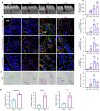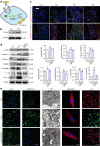Force-induced Caspase-1-dependent pyroptosis regulates orthodontic tooth movement
- PMID: 38221531
- PMCID: PMC10788340
- DOI: 10.1038/s41368-023-00268-7
Force-induced Caspase-1-dependent pyroptosis regulates orthodontic tooth movement
Abstract
Pyroptosis, an inflammatory caspase-dependent programmed cell death, plays a vital role in maintaining tissue homeostasis and activating inflammatory responses. Orthodontic tooth movement (OTM) is an aseptic force-induced inflammatory bone remodeling process mediated by the activation of periodontal ligament (PDL) progenitor cells. However, whether and how force induces PDL progenitor cell pyroptosis, thereby influencing OTM and alveolar bone remodeling remains unknown. In this study, we found that mechanical force induced the expression of pyroptosis-related markers in rat OTM and alveolar bone remodeling process. Blocking or enhancing pyroptosis level could suppress or promote OTM and alveolar bone remodeling respectively. Using Caspase-1-/- mice, we further demonstrated that the functional role of the force-induced pyroptosis in PDL progenitor cells depended on Caspase-1. Moreover, mechanical force could also induce pyroptosis in human ex-vivo force-treated PDL progenitor cells and in compressive force-loaded PDL progenitor cells in vitro, which influenced osteoclastogenesis. Mechanistically, transient receptor potential subfamily V member 4 signaling was involved in force-induced Caspase-1-dependent pyroptosis in PDL progenitor cells. Overall, this study suggested a novel mechanism contributing to the modulation of osteoclastogenesis and alveolar bone remodeling under mechanical stimuli, indicating a promising approach to accelerate OTM by targeting Caspase-1.
© 2024. The Author(s).
Conflict of interest statement
The authors declare no competing interests.
Figures








Similar articles
-
microRNA-21 Contributes to Orthodontic Tooth Movement.J Dent Res. 2016 Nov;95(12):1425-1433. doi: 10.1177/0022034516657043. Epub 2016 Jul 20. J Dent Res. 2016. PMID: 27422860
-
Force-induced Adrb2 in periodontal ligament cells promotes tooth movement.J Dent Res. 2014 Nov;93(11):1163-9. doi: 10.1177/0022034514551769. Epub 2014 Sep 24. J Dent Res. 2014. PMID: 25252876 Free PMC article.
-
Endo 180 participates in collagen remodeling of the periodontal ligament during orthodontic tooth movement.BMC Oral Health. 2024 Dec 31;24(1):1576. doi: 10.1186/s12903-024-05362-8. BMC Oral Health. 2024. PMID: 39741253 Free PMC article.
-
Neural regulation of alveolar bone remodeling and periodontal ligament metabolism during orthodontic tooth movement in response to therapeutic loading.J World Fed Orthod. 2022 Oct;11(5):139-145. doi: 10.1016/j.ejwf.2022.08.003. Epub 2022 Sep 27. J World Fed Orthod. 2022. PMID: 36175332 Review.
-
RANK/RANKL/OPG during orthodontic tooth movement.Orthod Craniofac Res. 2009 May;12(2):113-9. doi: 10.1111/j.1601-6343.2009.01444.x. Orthod Craniofac Res. 2009. PMID: 19419454 Review.
Cited by
-
Mesenchymal stem cell-derived exosomes: a potential cell-free therapy for orthodontic tooth stability management.Stem Cell Res Ther. 2024 Oct 1;15(1):342. doi: 10.1186/s13287-024-03962-3. Stem Cell Res Ther. 2024. PMID: 39354604 Free PMC article. Review.
-
Summed Tissue Resistance of Periodontal Ligaments and Alveolar Bone in Orthodontic Distal Retraction of Maxillary Canines: Mathematical Simulation of Clinical Data and Interpretation of Results.Dent J (Basel). 2025 Jan 27;13(2):55. doi: 10.3390/dj13020055. Dent J (Basel). 2025. PMID: 39996929 Free PMC article.
-
HDAC9-Mediated Pyroptosis Promotes Orthodontically Induced Inflammatory Root Resorption.Int Dent J. 2025 Jun;75(3):1828-1842. doi: 10.1016/j.identj.2025.03.018. Epub 2025 Apr 16. Int Dent J. 2025. PMID: 40245750 Free PMC article.
-
Emerging regulated cell death mechanisms in bone remodeling: decoding ferroptosis, cuproptosis, disulfidptosis, and PANoptosis as therapeutic targets for skeletal disorders.Cell Death Discov. 2025 Jul 21;11(1):335. doi: 10.1038/s41420-025-02633-3. Cell Death Discov. 2025. PMID: 40691135 Free PMC article. Review.
-
Advances in orthodontic treatment for periodontal disease: a bibliometric analysis, emerging insights and clinical implications.Front Dent Med. 2025 Jul 24;6:1600672. doi: 10.3389/fdmed.2025.1600672. eCollection 2025. Front Dent Med. 2025. PMID: 40777165 Free PMC article.
References
Publication types
MeSH terms
Substances
Grants and funding
LinkOut - more resources
Full Text Sources
Molecular Biology Databases

